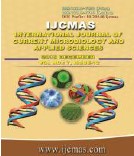


 National Academy of Agricultural Sciences (NAAS)
National Academy of Agricultural Sciences (NAAS)

|
PRINT ISSN : 2319-7692
Online ISSN : 2319-7706 Issues : 12 per year Publisher : Excellent Publishers Email : editorijcmas@gmail.com / submit@ijcmas.com Editor-in-chief: Dr.M.Prakash Index Copernicus ICV 2018: 95.39 NAAS RATING 2020: 5.38 |
Thematic maps present information relating to spatial variations in the distribution of specific geographical features at a regional scale or across the entire basin. The spatial distribution of thematic maps aids in decision-making of management of resources. Different thematic maps generated for the Kinnerasani basin include watershed boundary, drainage network, slope map, landuse/landcover map and soil map with the help of Survey of India topographical map and Cartosat DEM. LULC map was developed using IRS P6 LISS III satellite data. Deciduous forest is the major land use with 64% followed by crop land with 25% of the area of Kinnerasani basin. Water bodies are occupying an area of 3% followed by fallow land (2%). The basin consists of mainly two types of soils. Majority of the area is under Clay soils with 84 percent and Clay loam soil occupies 14 percent and remaining 2 percent is under rock and water bodies. Soil depth and productivity maps were also generated for sustainable land management.
 |
 |
 |
 |
 |